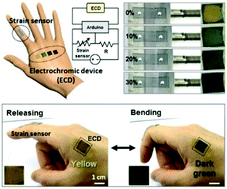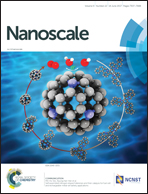A skin-integrated transparent and stretchable strain sensor with interactive color-changing electrochromic displays†
Abstract
In this study, we report on the development of a stretchable, transparent, and skin-attachable strain sensor integrated with a flexible electrochromic device as a human skin-inspired interactive color-changing system. The strain sensor consists of a spin-coated conductive nanocomposite film of poly(vinyl alcohol)/multi-walled carbon nanotube/poly(3,4-ethylenedioxythiophene):poly(styrenesulfonate) on a polydimethylsiloxane substrate. The sensor exhibits excellent performance of high sensitivity, high durability, fast response, and high transparency. An electrochromic device (ECD) made of electrochemically synthesized polyaniline nanofibers and V2O5 on an indium–tin-oxide-coated polyethylene terephthalate film experiences a change in color from yellow to dark blue on application of voltage. The strain sensor and ECD are integrated on skin via an Arduino circuit for an interactive color change with the variation of the applied strain, which enables a real-time visual display of body motion. This integrated system demonstrates high potential for use in interactive wearable devices, military applications, and smart robots.



 Please wait while we load your content...
Please wait while we load your content...